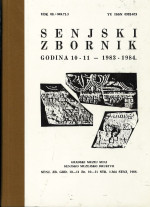NUMIZMATIČKE VIJESTI IZ SENJA I OKOLICE II
NUMISMATIC DATA FROM SENJ AND ITS SURROUNDINGS
Author(s): Zdenka Dukat, Ivan Mirnik, Jadranka NeralićSubject(s): Cultural history, Local History / Microhistory, Ancient World
Published by: Senjsko muzejsko društvo i Gradski muzej Senj
Keywords: numismatic data; Senj and its surroundingss;
Summary/Abstract: The very first attempt in order to compile a numismatic topography of the Senj area, but also including finds from other regions of Croatia, was made in 1889, when I. V. Žanić (1852—1920) published a detailed description of his coin collection. His efforts were pursued by Z. Dukat and A. Glavičić in 1975 in an article which showed the numismatic topography as seen when coin finds srom the Žanić collection were presented together with more recent finds from the local museum at Senj and some of the material kept in the Archaeological Museum in Zagreb. The present article is entirely based upon the coins from the Zagreb Collection. Among the treasure-troves five are listed, the most ancient being the Cesarica Hoard of 1936, buried under Tiberius, which is being published in detail elsewhere. At Karlo-bag to more Ancient hoards have been undug, but with insignificant, almost unidentifiable contents. The Novi Vinodolski Treasure contained French silver of the 11th cent, and is known in the literature in spite of its extremely reduced contents.In 1934 a hoard containing silver denarii of the Patriarchs of Aquileia was unearthed at Senj. Finally, a poor man's savings consisting almost entirely of Go-rician soldi of the 18 th cent, was discovered near Sv. Ilija. The individual coin finds give us an incomplete picture of money circulation in the area, because they are all fortuitous and ended up in the Zagreb Collection by accident. They do not represent a systematical collecting of material from a certain site. Among the sites Karlobag has produced most of the coins, and is being followed by Senj and Stinica. On the whole, twelve sites are represented. The earliest coins are a Roman Republican sextans from the 3rd cent. B. C. (Jur-jevo Б, 1) and a fragment of aes rude discovered by Josip Brunšmid at Karlobag (B, 2). Later on, more Roman Republican money was in circulation, particularly silver (Cesarica A; Karlobag B, 3—6). There are also several African specimens present: Carthaginian (Karlobag B, I) and Numidian bronze of the second cent. B. C. (Drvišica B, 1; Starigrad B, 2—10). Roman Imperial coins particularly of the first century, are well represented. From the 1st to the 3rd cents. A. D. almost all money arrived from the mint of Rome or some other Western mints, but in the late 3rd and in the 4th cents., as it seems, coins from the Eastern mints of the Empire began to be brought into the Senj area in more considerable quantities. There are almost no coins of the 5th cent., whereas of the Byzantine let us mention two gold pieces of Tiberius II Constantine (578—582) from Cesarica (B, I) and Jur-jevo (B, 8), one bronze of Justinian (527—565) and three more of Justin II (565—578) from Karlobag (B, 29—32). Among the more recent material, leut us only point out a Slavonian denarius struck by the banns Stjepan Babonić (1310—1316) at the mint of Zagreb, which strayed away from its usual monetary province.
Journal: Senjski zbornik - prilozi za geografiju, etnologiju, gospodarstvo, povijest i kulturu
- Issue Year: 11/1984
- Issue No: 1
- Page Range: 41-58
- Page Count: 18
- Language: Croatian

